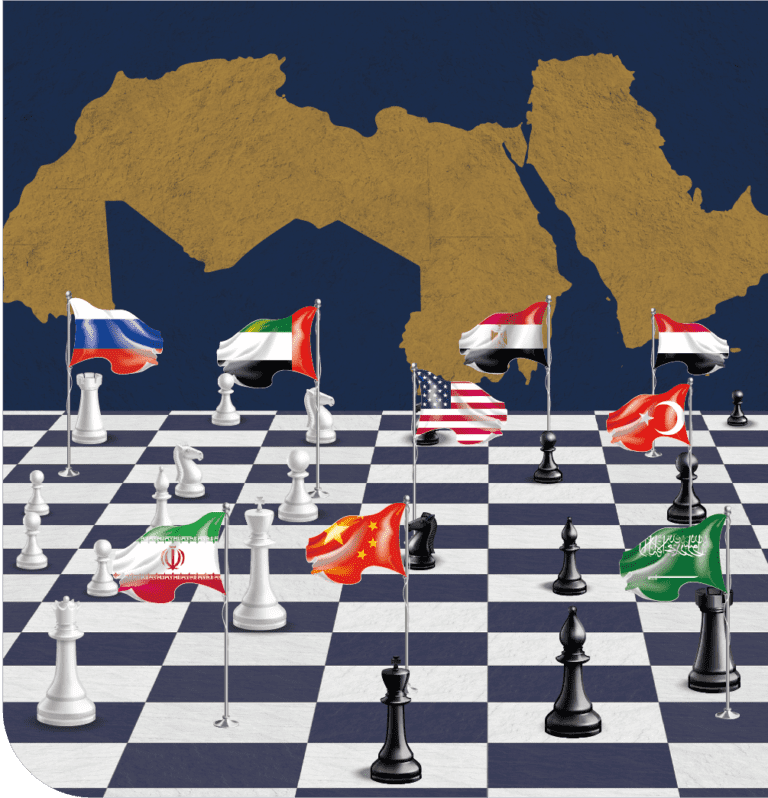
Women of the Gulf Break Labor Market Barriers:
A Journey in Progress
Issue Brief, March 2023
Key Takeaways
Gulf states have broken historical narratives around women’s economic participation: Over the past three decades, Gulf women have made remarkable strides in educational attainment and labor force participation. Today, they lead the Middle East and North Africa (MENA) region, with some countries on par with or exceeding global averages.
The transformation in girls’ education in the Gulf was a key factor: Gulf states invested heavily in making education more accessible for girls and young women. Over time, women’s educational attainment has soared, surpassing that of their male peers in most Gulf countries. These gains in education transferred, at least partially, into increased economic participation.
Public sector employment paved the way: The availability of suitable public sector jobs was a major factor driving Gulf women’s entry into the labor market, providing socially acceptable spaces for economic engagement. However, increases in population and the decline in oil revenues have limited citizens’ access to government jobs over time.
Women in some countries are making the transition into private sector employment: As Gulf countries diversify their economies and develop their private sector, private firms are increasingly providing an acceptable environment for women’s employment. Indeed, Bahraini, Omani, and Saudi women have transitioned successfully to the private sector.
Introduction
Women nationals in the six countries of the Gulf Cooperation Council (GCC) have made remarkable progress in terms of educational attainment and labor force participation. GCC countries now lead the Middle East and North Africa (MENA) region in terms of female employment among nationals (i.e., citizens). The rapid improvement in female economic participation in the Gulf has propelled them to the forefront of women’s economic empowerment in the MENA region. This goes against persistent historical narratives that depict the Gulf states as outliers in terms of repression of women’s economic, social, and political freedoms.
While substantial gains have been achieved, more needs to be done. GCC countries aspire to develop knowledge-based economies independent of oil and gas. To achieve this goal, they need to utilize the full capacities of their respective national workforces, especially those of educated women. However, while female nationals are graduating from higher education institutions in greater numbers than their male counterparts, their contributions to the labor market remain lower, indicating an underutilization of human capital. Indeed, many legal and social barriers to Gulf women’s full economic integration persist.
This issue brief documents the gains in economic participation that GCC women have achieved over the past five decades. It unpacks the forces behind these advances and highlights what must be done to sustain them. Our analysis finds that gains in female employment were due to increases in educational attainment and an expansion of high-paying jobs in the public sector sustained through revenues from hydrocarbons. It also finds that while these gains appear likely to persist in the post-hydrocarbon era, continued improvements will require additional reforms. Moreover, ongoing economic diversification efforts may erode gains in female economic participation over time unless policies are adopted to sustain them.
The Evolution of Female Labor Force Participation in the Gulf
Historically, women of the GCC had the lowest labor force participation rates in the MENA region, which in turn had the lowest labor force participation rates in the world.1 Constricting labor laws and a patriarchal gender contract—which held that men were the main breadwinners, responsible for securing income and sustenance for the household, while women were responsible for household work and family care—meant that GCC women were far less likely than men to enter the labor market. In addition, conservative social norms precluded women’s active participation in public life and limited their mobility. This was especially the case among more conservative segments of society, such as Bedouin communities and small villages, which restricted women’s contributions to the economy.2 As a result, in 1965, women represented less than 4% of the Bahraini workforce3 and only 2.5% of the workforce in Kuwait.4
Gulf countries began to modernize during the 1960s as revenues from oil began flowing in. They improved their infrastructure, making it easier and safer for people to get around, and began introducing social services, including increasing the number of public schools for girls. They also began hiring for government jobs, which provided women with a more regulated, safer, and socially acceptable working environment than the private sector. As a result, by the early 1970s, the situation began to change. Bahraini women increased their representation to 4.9% of the national workforce and Kuwaiti women increased their share to 3.3%.5 During the 1980s, rapid economic growth and educational expansion continued. Bahraini and Qatari women represented 13.7% and 16.8% of the national workforce in 1981 and 1983, respectively.6 In Kuwait, women’s share of the national workforce increased to 19.6% in 1985.7
In Saudi Arabia, conservative social norms were slower to change than in neighboring countries. This was induced by an ultra-conservative religious outlook and stronger clerical influence over the country’s social affairs. Saudi Arabia also had a much larger and more spread-out population, which served to slow the pace of social reform. Saudi women remained highly segregated and were unable to participate in public life or even, until recently, to drive cars. As a result, female participation in the Saudi labor market increased at a slower pace than in the rest of the GCC. As late as 1989, Saudi women’s share of the national workforce did not exceed 9%.8 While this was a marked improvement over what it had been two decades earlier, it was not on pace with the rest of the GCC. Recent reforms have greatly accelerated this change.
Historically, women’s work was discouraged because it placed them in contact with men who were not their close kin.9 This could be mitigated in work environments, such as the public sector, where interactions between the sexes could be limited and relegated to formal group settings. Over time, as female employment increased, it attracted more women who saw safety in numbers and wanted an opportunity to engage with their peers. This encouraged more employers to cater to them. Yet, while social norms regarding women’s work have loosened somewhat, traditional gender roles persist. Employed women are expected to manage their work around family needs. Even high-income women generally choose to concentrate on supporting their families and caring for their children, despite having access to paid domestic helpers. Interviews with Qatari female university students found that once married, their top priority is to their families and childcaring, irrespective of their educational and career goals.10
Breaking Barriers: The Role of Public Sector Employment and Education
During the past three decades, GCC governments invested heavily in human capital development and supported women’s employment. These efforts met with marked success. Today, female labor force participation among nationals in the GCC is considerably higher than the MENA average of 19%; some GCC countries are on par with or exceed the world average of 47% (figure 1).11 According to the latest available data, Kuwaiti women have the highest female labor force participation rates in the GCC at 54%. They are followed by Bahrain (47%) and Qatar (43%). Saudi women saw their participation rate skyrocket from 20% in 2018 to 35% in 2022. This dramatic social transformation followed the 2019 reforms, which provided greater economic opportunities and social mobility for Saudi women12 and demonstrated the magnitude of this population’s untapped potential. Even Omani women, who have the lowest participation rates in the GCC (31%), outperform the rest of MENA.
Source: Authors’ calculations based on national statistics.13
Education was a key factor in transforming female labor force participation. Over five decades, women’s educational attainment rates have increased dramatically, surpassing those of their male peers in most GCC countries. For example, the number of female Qatari university students in 2021 was nearly three times that of young men (figure 2).14 In Kuwait, it was more than double. Only in Oman was there a slightly higher share of young Omani men enrolled at university. Higher education levels led to an increase in economic participation. While these increases were lower than expected, Gulf women appear to have been more successful in transitioning from school to work than women in other MENA countries.15
There are several reasons behind this, beyond the financial ability of Gulf countries to provide free, high-quality education. Public schools and universities in the Gulf tend to be gender-segregated, removing a key potential objection to female schooling. Schools and universities are also places where young women can engage socially in countries where public spaces for women are limited. Also, girls’ schools tend to have female nationals as teachers, who provide mentorship and build a community of learners, while boys’ schools tend to employ foreign teachers, creating discipline problems and barriers to learning.16
Source: Authors’ calculations based on national statistics.17
A second major factor behind Gulf women’s success in the labor market was the availability of public sector jobs. Nationals, both men and women, have a strong preference for employment in the public sector as it offers higher wages, benefits, and job security than the private sector. For national women, the public sector also offers a safe, female-friendly working environment, longer maternity leaves, and shorter working-hours, allowing for a better work-family life balance.18 With the income generated from oil and (more recently) natural gas, Gulf countries were able to offer substantial public sector employment opportunities to their citizens, while allowing migrant workers to take up positions in the private sector. This both created employment opportunities for national women that were acceptable to them and their families and encouraged women to obtain the necessary education credentials to secure these positions and advance within the government bureaucracy.
Government Policies Boost Female Labor Force Participation
Over the years, GCC governments have also adopted policies aimed at improving women’s human capital development and labor market outcomes.19 The United Arab Emirates (UAE) established the General Women’s Union in 1975, which supports women’s needs and proposes legal amendments to benefit them.20 Both Qatar and Kuwait established business forums for women.21 Bahrain established a Supreme Council for Women to be consulted on key issues pertaining to women,22 while Saudi Arabia set up a framework creating more job opportunities for women in the educational field.23 Additionally, all the GCC countries, apart from Oman, have ratified the International Labor Organization’s (ILO) Convention No. 111 on job discrimination in the workplace.24 Saudi Arabia and the UAE have also ratified the ILO Convention No. 100 on equal pay for equal work for both men and women.25 These policies have helped improve the labor market conditions facing women.
Gulf countries have also adopted family-oriented measures that can make it easier for women to balance work and family obligations. Kuwait and Saudi Arabia provide pregnant women with up to 10 weeks of paid maternity leave, and Saudi Arabia requires establishments employing more than fifty women to provide childcare facilities. Qatar, the UAE, and Kuwait provide citizens with subsidized public childcare, while the latter also provides a child allowance.26 Qatar has recently granted nationals in the public sector the option of working part-time for half of the salary and other benefits. This new law comes as a way to strengthen families and parental involvement with their children.27 While policies enabling and supporting part-time work have not received as much prominence in some parts of the world, it is a policy that has great potential for Gulf countries to lead on as it aligns with the declared aspirations of women nationals.
Gulf states have also established programs designed to support young female nationals to enter and remain attached to the labor market. For example, the UAE launched training programs to help Emirati women prepare for the job market, along with mentorship programs connecting young female Emirati graduates with women in policy and legal careers, with the aim of breaking down barriers to labor market entry.28 Saudi Arabia implemented active labor market policies through its Hafiz program to boost female employment in the private sector. Although the program did not target women by design and did not result in sustainable changes in behavior, 80% of its job placement beneficiaries were women.29 In Kuwait, the Women’s Research and Studies Center conducted capacity building workshops to empower women,30 while in Oman, the Ministry of Technology and Communication established Community Knowledge Centers for Women across the sultanate to develop women’s information technology skills.31
Constraints to Female Labor Force Participation Remain
While GCC women’s employment gains should be celebrated, there remains much to be done. Despite steady improvements, the Gulf’s legal systems continue to limit women’s mobility and work-related decisions.32 Until recently, Saudi women were not allowed to drive and needed a guardian’s consent to work, apply for a passport and travel, or file a lawsuit.33 Laws also restrict women from working under certain conditions. For instance, women in Kuwait and Oman are not allowed to work at night, requiring permission from the Ministry of Labor to do so.34 Meanwhile, certain career streams are offered only to men in public universities. For instance, Qatar University only offers mechanical engineering to male students,35 while Omani women cannot serve as judges.36 Such misalignment between skills and opportunities suggests an underutilization of the full human capital capacities of the GCC.37
Importantly, public sector employment, which has played a vital role in enabling women nationals’ success in the labor market, has been in decline. Over the years, increases in population and a long-term decline in oil revenues have limited the ability of Gulf countries to offer government jobs to their citizens. As a result, citizens have taken to queuing for government jobs in most countries. This has led to increases in unemployment rates (figure 3), especially among young labor market entrants.38 In Saudi Arabia, the unemployment rate among women nationals stood at 29% in 2020 and 7% among their male counterparts. In Oman, the rate was 17% in 2020 as compared to 4% among Omani men. This means that even when they want to work, female nationals are finding it difficult to find suitable employment.
Source: Authors’ calculations based on national statistics.39
As Gulf economies diversify away from oil and gas, they must create a vibrant, productive private sector that can provide decent jobs for their citizens. Thus, to continue making gains in employment over the coming decades, Gulf women must make inroads into the private sector. While social norms may have adapted to the reality of women working, these norms must now adapt to the nature of this work. Gulf countries have indeed been developing their private sectors in order to diversify their economies. They have also introduced nationalization strategies to encourage citizens to seek private sector jobs and incentivize or mandate firms to hire them. Early indications are promising. In Gulf countries that are further along in diversifying their economies, namely Bahrain, Oman, and Saudi Arabia, national women are overcoming social norms and successfully transitioning to the private sector. In each of these three countries, the private sector now employs a greater share of national women than the public sector. This suggests that national women will be able to transition to the private sector work in other Gulf countries as well (figure 4).
Source: Authors’ calculations based on national statistics.40
That said, more needs to be done. For example, there are industries that women find it difficult to enter or advance in, including construction, engineering, and security. Women are more prevalent in sectors such as education, healthcare, and social services. Breaking into male-dominated sectors remains difficult because of discrimination, social norms, and a lack of interest among women themselves. Another issue is career advancement. Motivated by profit, private sector employers may be reluctant to invest in women’s development and training for fear that they will leave the company to start a family. Indeed, compared to men, women have less access to skill development programs and have limited career advancement opportunities. They also tend to earn lower wages for the same positions,41 although this is partly because they are willing to accept lower wages as they are not expected to contribute to family income. These are areas where state intervention may be necessary, including by providing access to lifelong training and upskilling opportunities as well as mandating that private firms offer women equal pay and opportunities.
A related issue is barriers to women’s ability to start businesses in the Gulf.42 Again, social norms play a role, but a more important reason includes legal barriers to securing a permit or a loan without the support of a male guardian or partner.43 Another issue is a lack of mentorship opportunities. The dearth of female business leaders and limits on social interactions with men means that female entrepreneurs cannot easily access the guidance and mentorship necessary to steer their initiatives to success. This creates a vicious cycle that limits the emergence of the next generation of women entrepreneurs.44 Increasing the prevalence of women-owned businesses would both increase female empowerment and create more employment opportunities.
Finally, Gulf women have limited social and political space to overcome these barriers. While they are increasingly reaching positions of authority in government, women are still more likely to occupy positions in ministries of education, public health, and social services. Women are less represented in Gulf legislative bodies and ministries that deal with issues related to the labor market, commerce, and administrative policy.45 They are also underrepresented on the boards of private companies and executive committees, which means their concerns are not sufficiently voiced within the private sector.46 Avenues for forming social initiatives, collective bargaining, and lobbying are also generally limited in Gulf countries. In addition, the lack of public spaces for women’s social gatherings like majalis and diwaniyat limits their networking and career guidance opportunities, further constraining aspiring female employees and entrepreneurs.47
Going Forward
Over the past five decades, Gulf women have made substantial strides in educational attainment and labor force participation. In this regard, the GCC leads the rest of the MENA region by wide margins. However, policymakers need to do more. Women in the Gulf continue to face barriers once they enter the labor market. Furthermore, a main driver of their employment in the past (public sector jobs) will play less of a role with the expected declines in oil revenues over the coming years. The continued success of GCC women’s march towards full economic inclusion will depend on their willingness and ability to secure jobs in the private sector.
In addition, women’s ability to maintain current levels of economic engagement should not be taken for granted. Over the past thirty years, female labor force participation witnessed massive reversals in countries throughout the MENA region in response to economic liberalization efforts and public sector retrenchment. In Egypt, for example, female labor force participation rates fell from 23% in 1994 to 18% by 2002, largely due to a decrease in the availability of public sector jobs. In Syria, rates fell from 21% in 2000 to 14% by 2007.48 As Gulf states seek to replace oil revenues with taxes on private sector activity, this will make private firms more cost-conscious and, possibly, more reluctant to offer women the services and benefits they have come to expect. Furthermore, one might expect the educational and career-related decisions of Gulf men to change in response to more limited employment opportunities, thus increasing competition for the same jobs.
Mindful of these trends, Gulf policymakers need to move quickly to remove the remaining barriers to female economic participation. Starting from educational pathways, young women should have equal opportunities to select, pursue, and advance within all careers. Additionally, greater female representation is needed in policymaking institutions and executive committees to ensure their concerns are voiced and their needs considered. Regulations need to be in place to make the private sector more women- and family-friendly, while avoiding measures that might increase costs. These might include providing more gender-segregated opportunities when possible and allowing more flexible and shorter working hours. Women in the GCC also need to secure basic rights related to their economic participation, including the right to make employment decisions, to have a passport and travel without guardian consent, and to participate in different social and decision-making activities.
Additionally, more focused effort is needed to increase female entrepreneurship, which remains low in the GCC.49 Simple steps like organizing workshops, conferences, and other networking events targeting aspiring female entrepreneurs would increase access to finance and address the absence of networking venues for women. These steps would also provide women with guidance and support, which are critical elements when starting a business. Furthermore, awareness campaigns at job fairs and student career services could communicate the long-term benefits of entrepreneurship for females, including the option of shorter and more flexible work hours.
Finally, additional data and research are needed to better understand and support women’s transitions. Ideally, data should track women over time to find out how many remain attached to the labor market after getting married and having children, and whether it is marriage or children that drives their decisions to leave. In addition, it would be good to consider women’s decision-making process about returning to work once their children are old enough. It is also important to know what share of young women wish to have lifelong careers versus what percentage are looking for something to do to keep them engaged socially, which may determine the potential to remain attached or return to work after leaving temporarily. Finally, it is critical to look at what policies and services might induce women to stay attached, such as the availability of part-time work and quality childcare facilities.





